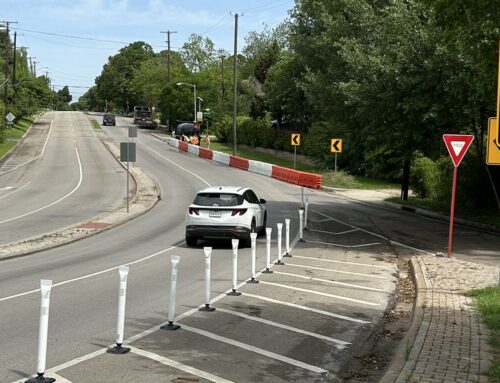A developer’s revised plan for the so-called Bishop Arts Gateway at Zang and Davis — with its cake-tiered buildings and mid-block paseos — comes much closer to what some neighborhood preservationists would like to see.
Alamo Manhattan’s new plan, presented to neighbors last week, came a couple of months after the developer’s original architectural renderings for those corners drew virtually unanimous disdain.
But those hated original designs are acceptable under the current zoning in Bishop Arts. Which is why the zoning needs to be changed, according to the Old Oak Cliff Conservation League.
The league has collected more than 2,000 signatures on a petition asking for the zoning to be amended. And they’ve raised about $6,300 in a Go Fund Me campaign.
It will cost about $10,000 to amend the zoning, says league past-president Michael Amonett.
Either City Councilman Scott Griggs or City Plan Commissioner Mike Anglin can “authorize a hearing to amend the PD.” That’s Planned Development District 830, or PD 830, aka the Bishop/Davis zoning ordinance. But more on zoning lingo later.
Fully reopening the case would cost more like $70,000 and could involve much more fighting among neighbors, Amonett says. Amending the ordinance means we can go in and change two or three things.
“I don’t want to fight,” he says. “I’m looking for the biggest coalition of people who can agree on the smallest number of things that people seem to be upset about.”
There are things in the Bishop/Davis zoning that have benefited the neighborhood, including easing parking restrictions, which allowed more businesses to open in old buildings.
The Old Oak Cliff Conservation League voted recently to ask the PD be amended to address three issues: building height, lot size and residential proximity slope. Those are three things that could’ve disallowed Alamo Manhattan’s “brick box that wasn’t,” and two of the three are addressed in the developer’s updated design.
By asking neighbors to put a little skin in the game in the way of donations, Amonett says they might decide to find out what “proximity slope” means or bother to attend slow City Hall meetings. Planning and zoning is so esoteric. It has its own language. It can be complicated and tedious. Even the word “zoning” can make one’s eyes glass over. But it’s what shapes the future of our neighborhood, all of Oak Cliff. We have to get involved or be ridden roughshod by landowners and developers, from Bishop Arts to Wynnewood and beyond.
So, residential proximity slope is a formula for how multi-story buildings are allowed to relate to one- or two-story buildings. It is a ratio between vertical and horizontal distances.
Here is a graphic, courtesy of Amonett, showing proximity slope for a 75-foot building, which currently is allowed in Bishop Arts and is the height of the proposed Alamo Manhattan buildings.







